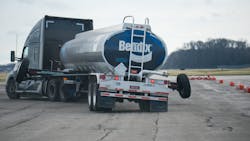Along with ADAS, modern tractor-trailers are also often equipped with stability technology to prevent a disastrous roll-over event by adjusting when each set of brakes activate. Stability systems have been mandated since 2017 on new heavy-duty tractors, and the technology is prevalent on trailers as well. Several components must work in concert to keep a fully-loaded tanker from tipping on an icy road, so technicians must be fully aware of how those interactions play out and how to diagnose issues.
Brian Screeton, Bendix Commercial Vehicle Systems technical service training supervisor, recently held an in-depth session at the company headquarters in Avon, Ohio, to help techs understand what each component of the Bendix ESP (Electronic Stability Program) full stability system does and how to troubleshoot some common issues.
“There is not much maintenance required unless there have been adjustments or repairs done to the chassis, such as chassis alignment or any steering or suspension system repair,” Screeton noted. “In these cases, calibration of the steering angle sensor would be required.”
One area he discussed that could confound troubleshooters is the yaw rate/lateral acceleration sensors (YRS). These sensors help detect an oversteering event that could cause a rollover. They work in conjunction with the ABS system, wheel speed sensors, and steering angle sensors, all of which are processed by the ECU. The system will then intervene if corrective action is required.
Some steps to diagnose an issue include: verifying proper installation and the correct YRS model is used, checking the wiring from the sensor to ECU, and ensuring that the sensor is securely mounted and not moved from its original location.
Techs must also be trained on how to correctly use the system’s diagnostic tools. Bendix safety systems all require the Bendix ACom Pro diagnostic software. In general, Screeton recommended drivers are well-versed in operation as well.
“With any safety system, the shops and fleets need to make the proper training of their drivers and technicians a priority,” Screeton said. “This will help the drivers explain any issues to the technicians accurately, and they will also know what to expect when the system may intervene. The technicians need a good understanding of how the system works and also of the correct diagnostic tools to be able to effectively maintain and diagnose any issues that may arise.”
About the Author
John Hitch
Editor-in-chief, Fleet Maintenance, Senior Editor, Trailer-Body Builders
John Hitch is the editor-in-chief of Fleet Maintenance, where his mission is to provide maintenance management and technicians with the the latest information on the tools and strategies to keep their fleets' commercial vehicles moving.
He is based out of Cleveland, Ohio, and has worked in the B2B journalism space for more than a decade.
Hitch was previously senior editor for FleetOwner, and covers everything related to trucking and commercial vehicle equipment, including breaking news, the latest trends and best practices. He previously wrote about manufacturing and advanced technology for IndustryWeek and New Equipment Digest.
Prior to that he was editor for Kent State University's student magazine, The Burr, and a freelancer for Cleveland Magazine. He is an award-winning journalist and former sonar technician, where he served honorably aboard the fast-attack submarine USS Oklahoma City (SSN-723).

